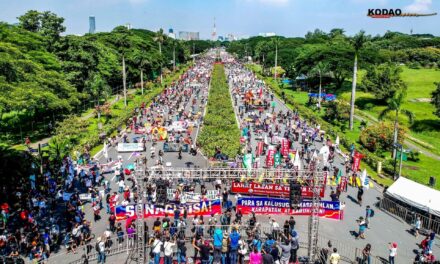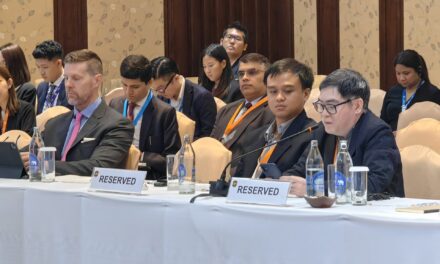By Walden Bello*
This article appeared originally in Foreign Policy in Focus, May 19, 2009
Will China be the “growth pole” that will snatch the world from the jaws of depression?
This is a question that has become a favorite topic as the heroic American middle class consumer, weighed down by massive debt, ceases to be the key stimulus for global production.
Despite the fact that the China’s GDP annual growth rate fell to 6.1 per cent in the first quarter—the lowest in almost a decade—optimists see “shoots of recovery” in a 30 per cent surge in urban fixed-asset investment and a jump in industrial output in March. These indicators are proof, some say, that China’s stimulus program of $586 billion—which, in relation to GDP, is much larger proportionally than the Obama administration’s $787 billion package–is working.
With China’s export-oriented urban coastal areas suffering from the collapse of global demand, many inside and outside China are pinning their hopes for global recovery on the Chinese countryside. A significant portion of Beijing’s stimulus package is destined for infrastructure and social spending in the rural areas. 20 billion yuan ($3 billion) worth of subsidies is being allocated to help rural residents buy televisions, refrigerators, and other electrical appliances.
The big question is, will this strategy of propping up rural demand to serve as an alternative to export demand as an engine for the country’s massive industrial machine work?
There are grounds for skepticism. For one, even when export demand was high, 75 per cent of China’s industries were already plagued with overcapacity.[1] Before the crisis, for instance, it was projected that by 2010, the automobile industry’s installed capacity could turn out 100 per cent more vehicles than could be absorbed by a growing market. In the last few years, overcapacity problems have resulted in the halving of the annual profit growth rate for all major enterprises.
The greater problem with the strategy of making rural demand a substitute for export markets is that even if another hundred billion dollars were thrown in, it is unlikely that the stimulus package will significantly counteract the depressive impacts of a 25-year policy of sacrificing the countryside for export-oriented urban-based industrial growth. This will have enormous implications for the future of the world economy.
Subordinating Agriculture to Industry
Ironically, China’s ascent during the last thirty years began with the rural reforms initiated by Deng Xiaoping in 1978. The peasants wanted an end to the Mao-era communes, and Deng and his reformers obliged them by introducing the “household-contract responsibility system.” Under this scheme, each household was given a piece of land to farm. Of what it produced, the household was allowed to retain what was left over after selling to the state a fixed proportion at a state-determined price, or by simply paying a tax in cash. The rest it could consume or sell on the market. There is consensus among China specialists that these were the halcyon years of the peasantry, when rural income grew by over 15 per cent a year on the average, and rural poverty declined from 33 per cent to 11 per cent of the population.
This golden age of the peasantry came to an end, however, and the cause was the adoption of a strategy of coast-based, export-oriented industrialization premised on rapid integration into the global capitalist economy. This strategy, which was launched at the 12th National Party Congress, in 1984, was essentially one that built the urban industrial economy on “the shoulders of peasants,” as rural specialists Chen Guidi and Wu Chantao put it.[2] Primitive capital accumulation was achieved mainly by policies that cut heavily into the peasant surplus.
The consequences of this urban-oriented industrial development strategy were stark. Peasant income, which had grown by 15.2 percent a year from 1978 to 1984, dropped to 2.8 percent a year from 1986 to 1991. Some recovery occurred in the early 1990s, but stagnation of rural income marked the latter part of the decade. In contrast, urban income, already higher than that of peasants in the mid-’80s, was, on average, six times the income of peasants by 2000.
The stagnation of rural income was caused by policies promoting rising costs of industrial inputs into agriculture, falling prices for agricultural products, and increased taxes, all of which operated to transfer income from the countryside to the city. But the main mechanism for the extraction of surplus from the peasantry was taxation. Taxes on 149 agricultural products were levied on the peasants by central state agencies by 1991, but this proved to be but part of a much bigger bite, as the lower levels of government began to levy their own taxes, fees, and charges. Currently, the various tiers of rural government impose a total of 269 types of tax, along with all sorts of often arbitrarily imposed administrative charges.
Taxes and fees are not supposed to exceed 5 percent of a farmer’s income, but the actual amount is often much greater; some Ministry of Agriculture surveys have reported that the peasant tax burden is 15 percent—three times the official national limit.
Expanded taxation would perhaps have been bearable had peasants experienced returns such as improved public health and education and more agricultural infrastructure. In the absence of such tangible benefits, the peasants saw their incomes as subsidizing what Chen and Wu describe as the “monstrous growth of the bureaucracy and the metastasizing number of officials” who seemed to have no other function than to extract more and more from them.
Aside from being subjected to higher input prices, lower prices for their goods, and more intensive taxation, peasants have borne the brunt of the urban-industrial focus of economic strategy in other ways. According to one report, “40 million peasants have been forced off their land to make way for roads, airports, dams, factories, and other public and private investments, with an additional two million to be displaced each year.”[3] Other researchers cite a much higher figure of 70 million households, meaning that, calculating 4.5 persons per household, by 2004, as many as 315 million people may have been displaced by land grabs.
But the impact of all these forces may yet be dwarfed by that of China’s commitment to eliminate agricultural quotas and reduce tariffs, made when it joined the World Trade Organization in 2001. The cost of admission for China is proving to be huge and disproportionate. The government slashed the average agricultural tariff from 54 percent to 15.3 percent, compared with the world average of 62 percent, prompting the commerce minister to boast (or complain): “Not a single member in the WTO history has made such a huge cut [in tariffs] in such a short period of time.”
The WTO deal reflects China’s current priorities. If the government has chosen to put at risk large sections of its agriculture, such as soybeans and cotton, this is because the party wants to open up or keep open global markets for its industrial exports. The social consequences of this trade-off are still to be fully felt, but the immediate effects were alarming. In 2004, after years of being a net food exporter, China registered a deficit in its agricultural trade. Cotton imports had skyrocketed from 11,300 tons in 2001 to 1.98 million tons in 2004, a 175-fold increase. Chinese sugarcane, soybean, and most of all, cotton farmers were devastated. In 2005, according to Oxfam Hong Kong, imports of cheap U.S. cotton resulted in a loss of $208 million in income for Chinese peasants, along with 720,000 jobs. Trade liberalization is also likely to have contributed to the dramatic slowdown in poverty reduction in the period between 2000 and 2004.
In the past few years, the priority placed on a capitalist transformation of the countryside to support export-oriented industrialization has moved the party to promote not only agricultural trade liberalization but a loosening of a semi-socialist property regime that favored peasants and small farmers. The process has involved easing public controls over land in order to move toward a full-fledged private property regime. The idea is to allow the sale of land rights (the creation of a land market) so that the most “efficient” producers can expand their holdings. In the euphemistic words of a U.S. Department of Agriculture publication, “China is strengthening farmers’ rights—although stopping short of allowing full ownership of land—so farmers can rent land, consolidate their holdings, and achieve efficiencies in size and scale.”[4]
The liberalization of land rights included the passage of the Agricultural Lease Law in 2003, which curtailed the village authorities’ ability to reallocate land and gave farmers the right to inherit and sell leaseholds for arable land for thirty years. With the buying and selling of rights to use land, private property in land was essentially reestablished in China. In talking about “family farms” and “large-scale farmers,” the Chinese Communist Party was, in fact, endorsing a capitalist development path to supplant one that had been based on small-scale peasant agriculture. As one partisan of the new policy argued, “The reform would create both an economy of scale—raising efficiency and lowering agricultural production costs—but also resolve the problem of idle land left by migrants to the cities.”[5]
Despite the assurance by the party that it was institutionalizing the peasants’ rights to land, many feared that the new policy would legalize the process of illegal land grabbing that had been occurring on a wide scale. This would, they warned, “create a few landlords and many landless farmers who will have no means of living.”[6] Given the turbulent transformation of the countryside by the full-scale unleashing of capitalist relations of production in other countries, these fears were not misplaced.
In sum, simply allocating money to boost rural demand is unlikely to counteract the massive weight of the economic and social structures created by policies that subordinated the development of the countryside to export-oriented industrialization. These policies have contributed to greater inequality between urban and rural incomes and stalled the reduction of poverty in the rural areas. To enable the rural areas of China to serve as the launching pad for national and global recovery would entail a fundamental policy shift, and the government would have to go against the interests, both local and foreign, that have congealed around the strategy of foreign-capital-dependent, export-oriented industrialization.
Beijing has talked a lot about a “New Deal” for the countryside over the last few years, but there are few signs that it has the political will to adopt policies that would translate its rhetoric into reality.
*Walden Bello is a member of the Philippine House of Representatives, president of the Freedom from Debt Coalition, and senior analyst of the Bangkok-based Focus on the Global South. The issues touched on in this commentary are discussed in greater depth in the author’s book The Food Wars, published by Verso, which will be available by July 2009.
[1] Ho Fung Hung, “Rise of China and the Global Overaccumulation Crisis,” Review of International Political Economy, Vol. 15, No. 8 (May 2008).
[2] Chen Guidi and Wu Chantao, Will the Boat Sink the Water? (New York: Public Affairs, 2006).
[3] C. Fred Bergsten, Bates Gill, Nicholas Lardy, and Derek Mitchell, China: the Balance Sheet (New York: Public Affairs, 2006).
[4] Bryan Lohmar and Fred Gale, “Who Will China Feed?” Amber Waves, June 2008, http://www.ers.usda.gov/AmberWaves/June08/Features/ChinaFeed.htm.
[5] Lu Zixiu, an expert on rural affairs, quoted in Antonaneta Bezlova, “Flirting with Land Tenure Reforms,” Inter-Press Service, October 13, 2008.
[6] “China Liberalizes Farmers’ Land Use Right to Boost Rural Development,” Xinhua, October 19, 2008; http://news.xinhuanet.com/english/2008-10/19/content_10218172.htm.









